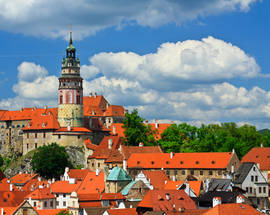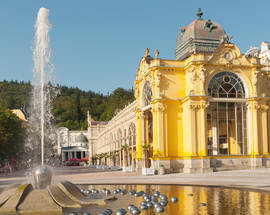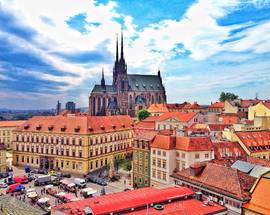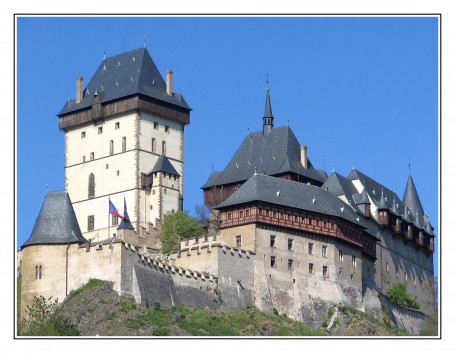
After poking around all the glass shops, take a daytrips to see the pretty Czech countryside and towns surrounding Prague, easily reached using public transport. Escape the crowds and follow us to the best castles and nature near the capital.
Karlštejn Castle
The Czech Republic's most impressive and most-visited castle is just 33km south of Prague, and is the easiest daytrip you can make from the city.
The castle, impressively draped over a hillside with the massive 60-metre Great Tower dominating the lower Marian Tower and Imperial Palace, was built in 1348 by the Czech King and Roman Emperor Charles IV as a safe place to keep the royal treasures, including the priceless collection of holy relics and Roman Empire coronation jewels. The building was finished in 1365 with the consecration of the Chapel of the Holy Cross. The castle was used to hide the Czech coronation jewels during the Hussite wars. The building has changed considerably over the ages, undergoing reconstructions in late Gothic style around 1480, in Renaissance style in the 16th century, and finally in neo-Gothic style in the 19th century.
Inside, two different guided tours of the interiors are available. Tour 1 (available year-round, 50 minutes, 220/120Kč) takes you though the Imperial Palace and the lower floors of the Marian Tower. Tour 2 can only be joined if booked well in advance (until 31 October, 70 minutes, 300/100Kč plus 30Kč reservation fee), with just 12 visitors at a time allowed in. This tour includes the Marian and Great towers, the Church of Our Lady, the sacristy, picture gallery, and library. The highlight of the tour is the newly renovated Chapel of the Holy Cross, a spectacular place of worship that is home to a collection of 129 panel paintings and 14th century wall paintings. The chapel also holds a replica of St. Wenceslas' crown and the castle well.
Karlštejn Castle is open 09:00-18:00 in August, 09:00-17:00 in September, closed on Mondays and between 12:00-12:30. For more information and bookings, call 311 681 617, email to rezervace@stc.npu.cz, or visit www.hradkarlstejn.cz.
Trains depart from Prague Hlavní nádraží (main) station at least every hour (at 25 minutes past the hour), and return twice an hour from Karlštejn station (at 27 and 57 minutes past the hour). From the station it's a 30-minute walk through the tourist-tat-infested village and up the hill to the castle, or you can take a horse-drawn carriage up.
Further on the same line as Karlštejn is Pilsen (or Plzen), home to Pilsner Urquell, the first golden lager in the world. Since 1842, the brewery has been keeping beer drinkers happy and today you can join a tour (daily at 12:30 & 14:00, 120Kč) and sample some unfiltered and unpasteurized Pilsner Urquell from the underground sandstone tunnels. Pilsen also has a zoo, one of the largest town squares in the country as well as one of the highest towers on St. Bartolomew's plus a brewery museum. Pilsen lies 114km south west of Prague and trains from Prague Hlavní nádraží run regularly and take about 1hr 40mins. More info https://www.inyourpocket.com/Plzen
Český ráj
For a breath of fresh air, head 100km north of Prague to the beautiful Český ráj (Bohemian Paradise). Here, wind and water have eroded the soft yellow sandstone into massive pillars up to 60 metres high (named ‘rock towns’) that tower over the visitors. The whole area is cloaked in beautiful forest and is dotted with spectacular castles – a perfect destination for a daytrip, walking along the well-marked paths. The sandstone formations are found in two main concentrations, the Hruboskalsko (‘fat rock’) area just south of Turnov, and the Prachovské skály (‘dusty rocks’) area, more to the east near Jičín.
The Hruboskalsko area is four kilometres from Turnov and you can walk from the centre of town to the rocks in about an hour. After passing the 13th century Valdštejn castle with its pretty bridge you can choose to follow the yellow or blue trails and wander up and down the steps and trails between the 400 rock towers, or you can stay on the red promenade path that stays high up, passing several spectacular viewpoints. The yellow trail passes a poignant memorial for all Czech climbers who died on mountains around the world. You can walk a full circuit in under two hours. At the end of the red trail, the dainty Hrubá Skála chateau (www.hrubaskala.cz, tel. 481 65 91 11) sits atop a rock dramatically overlooking the valley – the perfect place for a lunch break in the upmarket but reasonably priced castle restaurant – sample the excellent mushroom or game dishes. There’s also a hotel in the complex with a range of very cheap to more pricey rooms.
The smaller Prachovské skály area (admission 50Kč) has been a protected tourist attraction since 1933, and is four kilometres from Jičín. A dense network of paths connects the narrow clefts and viewpoints; delightful for young and old alike to scramble around. In the middle of it all, the charming hotel Pod Šikmou věží (tel. 493 533245,sikma.vez@tiscali.cz) offers cheap, decent lodging and food in a quiet spot near the rocks.
The best way to reach the Český ráj by public transport is to take a bus to Turnov; the trip takes between 1hr 20mins and 2hrs depending on if you need to connect at Mladá Boleslav. A few direct trains per day make the 2-hour journey too. Several buses a day connect Prague’s Černý Most bus station to Jičín (1hr 20min). Within the area, the seasonal bus link between Turnov and Jičín allows you to make a round trip visiting both areas. Note that renting a small car from a rental company such as Sixti (www.sixti.com) is almost as cheap as taking the bus. For more information, route descriptions and seasonal bus timetables, seewww.cesky-raj.info/en.
Kutná Hora
Just 77km east of Prague lies beautiful Kutná Hora; eight trains trundle to and fro every day, costing 98Kč and taking about one hour. The 10:01 departure from Hlavní nádraží is a useful one (arr. 11:06), allowing a relaxed banter around town, lunch and dinner in time for the 19:02 or 21:02 services back to Prague (arr. 20:01 and 22:01). The bus from the station into town passes the infamous ossuary (bone chapel) at Sedlec, which you can walk to from the station; keep an eye out for the appropriately placed Phillip Morris cigarette factory. You'd be hard pressed to miss the towering spires and hysterical English handout to St. Barbara's Cathedral. Also, explore the Alchemy Museum. More info https://www.inyourpocket.com/Kutna-Hora
Karlovy Vary, the pleasant spa town 200km west of Prague, can be reached in 4-5 hours by train, so it's not quite a day trip but worth heading out to explore anyway. Six to nine trains per day head there and back, departing from different stations in Prague. More info https://www.inyourpocket.com/Karlovy-Vary
Český Krumlov
Perhaps the most worthwhile trip out of Prague is to romantic Český Krumlov, 170km southwards. It can just be done in a very long day (by taking the 07:10 bus out and the 17:30 bus back), but you’d spend more time travelling than enjoying yourself - it’s best to relax and take advantage of the excellent local hotels, guest houses and restaurants, and make it a two-day trip, perhaps taking in České Budějovice on the way out or back. Eleven direct daily buses, much faster than train connections, depart from Prague’s bus stations, taking about 3 hours. More info https://www.inyourpocket.com/cesky-krumlov
200km south of Prague, České Budějovice, home of Budvar beer, is well worth a visit. Fourteen trains per day make it there and back, taking 2hrs 30mins. Trains from Prague Hlavní nádraží depart irregularly in the morning, hourly in the afternoon.
Kroměříž
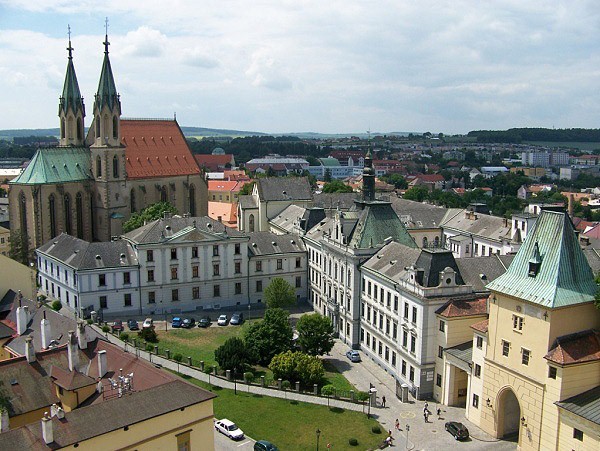
Kroměříž was established as a market town at the crossroads of trading routes. At the time of the church colonisation in the first half of the 12th century it became the property of the Bishops of Olomouc. The village was elevated to town status in the second half of the 13th century, but the religious wars of the 14th century inflicted terrible wounds on the town.
The year 1848 was a milestone in the town’s history, when the Constituent Assembly of the Austrian Monarchy was transferred here, and a period of progress began which elevated the town to the highest levels of spiritual culture and art. It is not only interesting for its history and architecture, but also the surrounding nature, which offers visitors a large number of free-time options.
Each year the city plays host to a number of music festivals, exhibitions, conferences and congresses, and the gardens and château were inscribed in the UNESCO World Cultural and Heritage List in 1998.
.http://www.mesto-kromeriz.cz/


